Rædwald of East Anglia facts for kids
Quick facts for kids Rædwald |
|
|---|---|
| Bretwalda | |
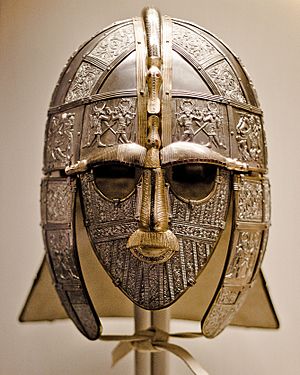
A replica of the Sutton Hoo helmet, the original of which may have belonged to Rædwald
|
|
| King of the East Angles | |
| Reign | c. 599 – c. 624 |
| Predecessor | Tytila |
| Successor | Eorpwald |
| Died | c. 624 |
| Burial | considered by many experts to be the occupant of the ship-burial at Sutton Hoo, Suffolk |
| Spouse | unknown |
| Issue | Rægenhere and Eorpwald of East Anglia |
| Dynasty | Wuffingas |
| Father | Tytila of East Anglia |
| Religion | Syncretic pagan-Christian |
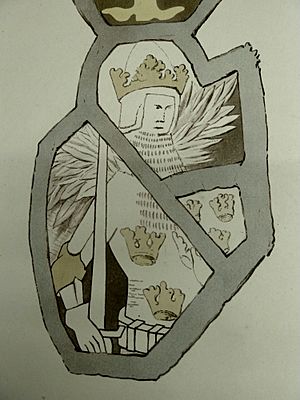
Rædwald (which means 'power in counsel' in Old English) was a powerful king of East Anglia. This was an Anglo-Saxon kingdom in what is now eastern England, including Norfolk and Suffolk. He was the son of Tytila of East Anglia and part of the Wuffingas royal family. They were the first kings of the East Angles.
Rædwald ruled from about 599 until his death around 624. At first, he was under the control of Æthelberht of Kent. But in 616, Rædwald fought and won the Battle of the River Idle against Æthelfrith of Northumbria. This victory allowed him to make Edwin the new king of Northumbria, who then followed Rædwald's lead. Sadly, Rædwald's son, Rægenhere, was killed in this battle, as was Æthelfrith.
After 616, Rædwald became the strongest king in southern England. A historian named Bede said he was the fourth ruler to have imperium, which means power over other southern Anglo-Saxon kingdoms. Later, the Anglo-Saxon Chronicle called him a bretwalda, meaning 'Britain-ruler' or 'wide-ruler'. Rædwald was the first king of the East Angles to become a Christian. He converted in Kent before 605, but he also kept a pagan temple. He helped Christianity survive in East Anglia when other kingdoms turned away from it. Many historians believe Rædwald was buried in the famous Sutton Hoo ship-burial. A smaller ship-burial found nearby in 1998 might hold the body of his son Rægenhere.
Contents
Anglo-Saxon Kingdoms: Rædwald's World
The Angles, Saxons, Jutes, and Frisians started arriving in Britain in the 400s. By the year 600, several kingdoms had formed in the lands they had taken over. By the early 600s, most of southern England was under their control.
During Rædwald's younger years, other royal families were also becoming powerful. For example, Æthelberht of Kent married Bercta, a Christian princess from the Franks, before 588. Also, Ceawlin of Wessex, a very strong ruler, pushed back Æthelberht in 568. The kingdom of Mercia was founded around 585 by Creoda.
North of the Humber River, the kingdoms of Deira and Bernicia had rival royal families. Ælla ruled Deira until 588, leaving behind his son Edwin. The Bernician family, related to Wessex, became stronger than Deira. This forced Edwin to live in exile with Cadfan ap Iago in Gwynedd. Around 604, Æthelfrith of Bernicia united the Northumbrian state, taking control of Deira.
Rædwald's Family Life
Rædwald was born sometime between 560 and 580. He was the son of Tytila, whom he replaced as king. He was also the older brother of Eni. According to Bede, Rædwald was a descendant of Wuffa, who started the Wuffingas royal family.
In the 590s, Rædwald married a woman whose name we don't know. We do know from Bede that she was a pagan (not Christian). They had at least two sons: Rægenhere and Eorpwald. Rædwald also had an older son named Sigeberht. Sigeberht's name was different from other Wuffingas names. Some people think Rædwald's queen might have been married before to someone from the royal family of Essex, making Sigeberht Rædwald's stepson. Rædwald sent Sigeberht away to Gaul (modern-day France), possibly to protect his own family's claim to the throne.
| Wehha | |||||||||||||||||||||||||||||||||||||||||||||
| Wuffa | |||||||||||||||||||||||||||||||||||||||||||||
| Tytila | |||||||||||||||||||||||||||||||||||||||||||||
| ? | Rædwald | ? | Eni | ? | |||||||||||||||||||||||||||||||||||||||||
| Sigeberht | Rægenhere | Eorpwald | |||||||||||||||||||||||||||||||||||||||||||
For a family tree that includes the descendants of Eni, see Wuffingas.
Rædwald's Early Rule and Christian Faith
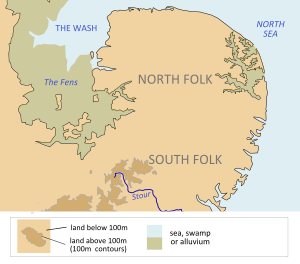
During Rædwald's early reign, important events happened. Augustine of Canterbury arrived from Rome in 597 to spread Christianity. Kings Æthelberht of Kent and Saeberht of Essex became Christians. New church leaders were set up in their kingdoms. Bede, a historian, wrote that Rædwald became Christian in Kent. This likely happened around 604 or later, possibly invited by Æthelberht, who might have been his sponsor.
Rædwald's conversion was not fully accepted by his family, especially his queen. She and her pagan teachers convinced him to partly go back on his Christian promise. So, he kept two altars in his temple: one for pagan gods and one for Christ. Bede wrote that Ealdwulf of East Anglia, Rædwald's nephew, remembered seeing this temple when he was a boy. Historians think it might have been in Rendlesham, an important place for the Wuffingas family. Some historians believe Rædwald didn't fully embrace Christianity because converting through Æthelberht would have meant admitting he was less important than the Kentish king. Bede was unhappy with Rædwald for not fully committing to Christianity.
Rædwald and Edwin of Northumbria
Edwin's Escape to Rædwald
Æthelfrith of Northumbria wanted to get rid of Edwin, who was a threat to his rule. Edwin had to flee and found safety with Rædwald. Rædwald promised to protect him, and Edwin lived among the king's royal friends.
When Æthelfrith heard about Edwin being with Rædwald, he sent messengers. He offered Rædwald money to kill Edwin. Rædwald refused. Æthelfrith sent messengers two more times, offering even more money and threatening war if Rædwald didn't agree. Rædwald almost gave in and considered killing Edwin or handing him over.
Edwin had a chance to escape to another safe country, but he chose to stay with Rædwald. Then, a stranger visited Edwin. This stranger knew about Rædwald's thoughts. The story says the stranger was Paulinus of York, a Christian missionary. Paulinus offered Edwin hope that Rædwald would support him. He also suggested Edwin might become a more powerful king than any before him. Edwin promised Paulinus he would accept Christian teachings if he survived and gained power.
Rædwald's pagan queen told him off. She said it was dishonorable for a king to betray his friend for money. Because of her words, Rædwald decided to go to war against Æthelfrith.
The Battle of the River Idle
In 616 or 617, Rædwald gathered his army and marched north. His son Rægenhere went with him. They met Æthelfrith's army on the east bank of the River Idle. The battle was very fierce. People remembered it by saying, 'The river Idle was foul with the blood of Englishmen'.
During the fight, both Æthelfrith and Rædwald's son Rægenhere were killed. After the battle, Edwin became the new king of Northumbria. Æthelfrith's sons had to leave the kingdom.
Another story of the battle says Rædwald's army was in three groups, led by Rædwald, Rægenhere, and Edwin. Æthelfrith's experienced fighters attacked. They saw Rægenhere, perhaps thinking he was Edwin, and killed him. After his son's death, Rædwald fought furiously. He broke through the enemy lines and killed Æthelfrith, causing many Northumbrians to die.
Historians like D.P. Kirby suggest this battle was more than just a fight over an exiled nobleman. It was a big struggle to decide who would lead the Anglian people at that time.
Rædwald's Great Power
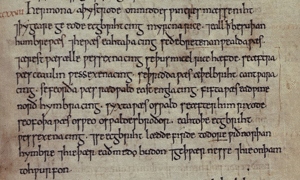
On February 24, 616, the year of the Battle of the River Idle, Æthelberht of Kent died. His pagan son Eadbald became king. After the Christian Saebert of Essex died, his three sons took over. They brought back pagan rule and forced the Christian missionaries to leave.
During this time, Rædwald had the only Christian altar among the kings in England. By the time he died, Christianity was fully back in Kent.
Rædwald's power grew so much that Bede called him the successor to Æthelberht's imperium. Bede also called him Rex Anglorum, which means 'King of the Angles'. This was a title used for a powerful overlord. We don't know exactly where his power was centered or how he gained control over the Angles in eastern England.
Because Edwin owed him loyalty, Rædwald became the first foreign king to have direct influence in Northumbria. He played a key role in making sure Edwin was securely established as king of both Deira and Bernicia.
The Growth of Ipswich
In the early 600s, the port settlement at Gipeswic (now Ipswich) became an important trading center. Goods like pottery were brought in from other trading places around the North Sea. Historians believe that the Wuffingas family started Gipeswic. It took another hundred years for it to become a town, but its beginnings show how important Rædwald was during his time of power.
Rædwald's Death
Rædwald is thought to have died around 624. His death date is not exact, but it was a few years after Æthelberht died. This allowed him to be known as a bretwalda. Some historians suggest he died before Edwin became Christian in 627.
His death is recorded twice by Roger of Wendover, in 599 and 624. The 599 date is now believed to be a mistake for his father Tytila's death. So, 624 is generally accepted as the year Rædwald died.
His pagan son Eorpwald took over as king. Later, Edwin of Northumbria convinced Eorpwald to become a Christian.
Sutton Hoo: A Royal Burial?
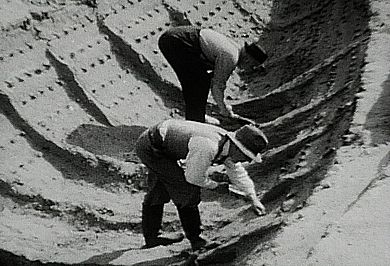
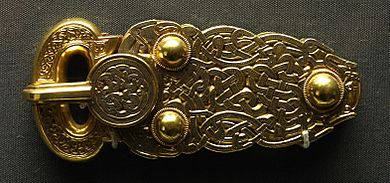
Rædwald lived at a time when important people were buried in large mounds called barrows at the Sutton Hoo cemetery. This site is near Woodbridge, Suffolk. Today, you can still see these large mounds overlooking the River Deben. They were originally much taller and easier to spot.
In 1939, a mound at Sutton Hoo, now called Mound 1, was found to contain an incredibly rich Anglo-Saxon ship-burial. Inside the mound was a ship, about 27 meters (89 feet) long, that had been used at sea and repaired. In the middle of the ship was a chamber filled with amazing jewelry and other valuable items. These included silver bowls, drinking cups, clothes, and weapons.
One unusual item was a large 'sceptre' shaped like a whetstone. It showed no signs of being used as a tool. Some believe it was a symbol of the bretwalda office. The gold and garnet items found were made for a very important person. The craftsmanship was as good as any in Europe. These items were designed to show off great power. The silver items from the Mediterranean found in the grave are unique for that time in Europe.
The amazing quality of these objects, both personal items and symbols of power, suggests that a very important person was buried there. Rupert Bruce-Mitford, a historian, believes it was "very likely the monument of the High King or bretwalda Rædwald." Another historian, Barbara Yorke, thinks the treasures show how much tribute Rædwald received from other kings when he was the bretwalda. Bruce-Mitford also suggested that the bowls and spoons found fit with Bede's story of Rædwald's conversion. The spoons might have been a gift for someone converting to Christianity, and the bowls had Christian meaning. Coins found in the burial date to around the time Rædwald died.
However, not everyone agrees that it was Rædwald. The Oxford Dictionary of National Biography says the arguments for Rædwald are "more strongly than convincingly." Other ideas include other East Anglian kings or a rich foreign visitor. Some even think it might have been a wealthy person who wanted to show off their status, not necessarily a king. However, Rendlesham, a known home of the East Anglian kings, is only 4 miles (6.4 km) away.
Some experts have noticed similarities between the armor and burial style at Sutton Hoo and finds from the Vendel Period in Sweden. This led some to suggest that the Wuffingas family came from Scandinavia. But there are also big differences, and exact matches for the Sutton Hoo items haven't been found elsewhere. So, this connection is generally not proven.
It's also possible that the mound is a cenotaph (a monument to someone buried elsewhere) rather than a grave. The only sign of a body was a chemical stain, which could have other causes. Also, there were no clear signs of clothes or items that would have been on a body. However, newer tests found phosphate in the soil, which suggests a human body was once there. The idea of a cenotaph might fit with the change from pagan to Christian burials. For Rædwald, he could have had a Christian burial, and the mound could have been a memorial and a symbol of the East Anglian kings' power.
See also


